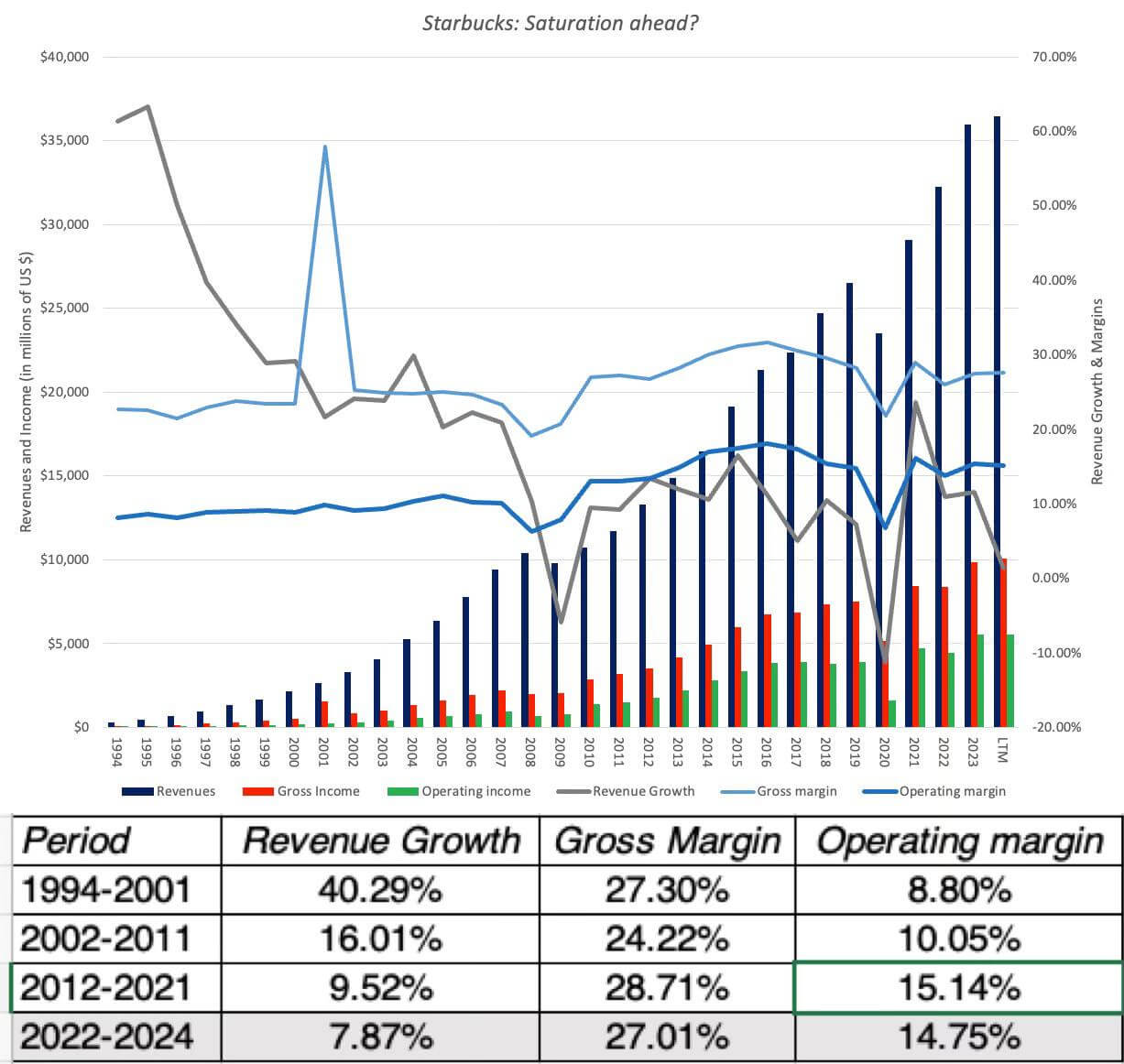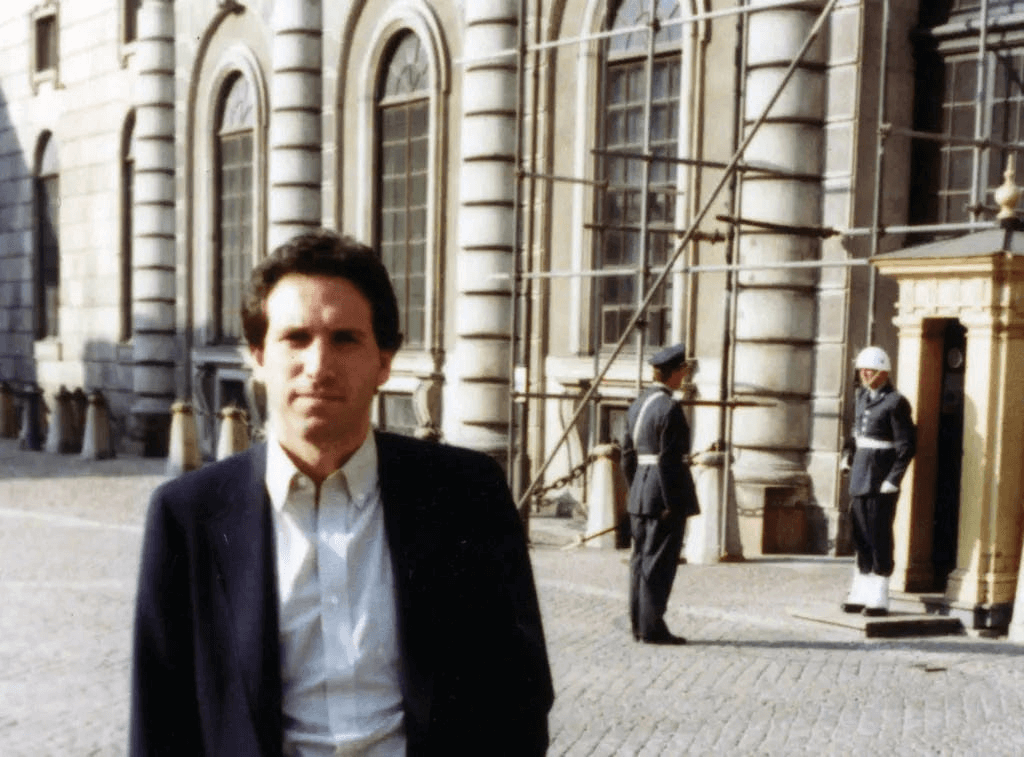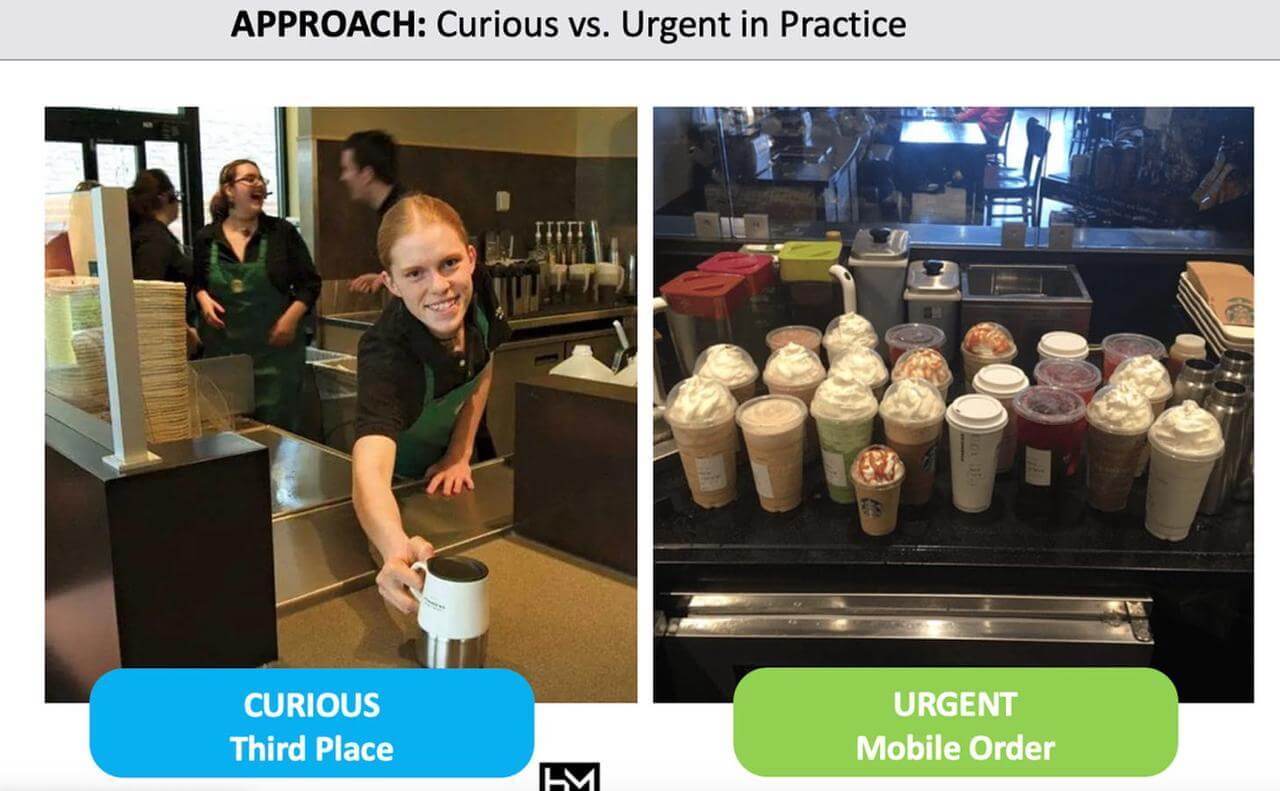하이라이트:
스타벅스 CEO로 2018년 취임한 이후, 브라이언 니콜(Brian Niccol)은 6년 만에 회사 주가를 800% 상승시켜 미주식 시장의 기적이라 불릴 수 있습니다. 그가 스타벅스 CEO로 합의한 날, 후자의 주가는 거의 25% 급등했습니다(시가총액 증가액이 200억 달러를 초과).
글로벌 커피 거대 기업인 스타벅스는 지난 1-2년간 미주식 시장에서 인기를 잃었으며, 여러 운영 지표(예: 매출 성장률)가 낙관적이지 않습니다. 초기의 고속 매출 성장은 더 이상 존재하지 않지만, 현재 이익률은 상당히 강합니다.
스타벅스는 심각한 중년 위기에 직면해 있습니다. 최근 몇 년간 모든 문제의 근본 원인은 "디지털화로 성공하고 디지털화로 실패"입니다. 매출 규모는 여전히 거대하지만, 투자자들이 믿을 수 있는 "거대한 서사"를 잃었습니다. 이러한 "서사"를 찾기 위해서는 식음료 운영의 다양한 도전을 이해하는 비전 있는 리더가 필요합니다.
니콜의 이력은 식음료 업계에서의 뛰어난 성과를 보여줍니다. 그는 멕시칸 바베큐의 대규모 전환을 이끌고 성공적으로 급상승하는 패스트푸드 제국으로 변모시켰습니다. 향후 몇 달은 그가 새로운 역할에 적응하고 스타벅스를 또 다른 미래로 이끌기 시작하는 중요한 시기입니다.
소개:
지난 6년간, 식음료 업계의 빛나는 새로운 스타가 미주식 시장에서 열띤 논의를 불러일으켰습니다. 이 레스토랑은 치폴레(Chipotle, 멕시칸 스타일 바베큐)라고 불리며, 그 CEO는 2018년 취임 이후 6년 만에 회사 주가를 800% 상승시켰습니다. 같은 기간 동안 S&P 500 지수 구성 종목 중 9개만이 치폴레보다 더 나은 성과를 보였습니다.
9월 9일, 치폴레의 식음료 기적을 달성하는 데 도움을 준 영혼 인물인 브라이언 니콜이 2년 만에 스타벅스의 네 번째 CEO로 공식 취임했습니다. 발표 당일, 스타벅스 주가는 거의 25% 급등했으며(시가총액이 200억 달러 이상 증가), 지난 한 달 동안 주가가 하락하지 않았습니다. 시장은 브라이언 니콜이 스타벅스가 지난 3년간의 회사 발전 역풍을 역전시키고 상승 사이클로 돌아올 수 있도록 도울 것으로 기대하고 있습니다. 하지만 그럴까요?
RockFlow의 투자 연구팀은 지난 몇 년간 스타벅스를 둘러싼 어려움과 위기를 검토하고, 새로운 CEO 브라이언 니콜이 이전 이력과 성과를 바탕으로 스타벅스를 성장으로 이끌 가능성을 분석할 것입니다.
RockFlow는 계속해서 미주식 시장의 고품질 기업들의 후속 발전과 최신 시장 동향을 추적할 것입니다. 관련 기업들의 발전 개요, 투자 가치, 위험 요소에 대한 자세한 이해를 원하시면 RockFlow가 이전에 발표한 여러 심층 정리 및 분석 기사를 확인하실 수 있습니다:
1. 스타벅스에 무슨 일이 있었나요?
스타벅스는 1971년 시애틀에서 커피 원두 도매업체로 설립되었으며, 나중에 하워드 슐츠(Howard Schultz)에 의해 커피 체인으로 변모했습니다. 이탈리아인들에게 놀랍게도, 미국 회사가 전 세계적으로 에스프레소를 재정의했습니다.
초기에는 더 많은 매장을 열어 "제3의 공간"을 제공했습니다. 최근 몇 년간 온라인 주문, 자가 픽업/배달의 새로운 트렌드를 따랐으며, 회원제와 리워드 활동을 강화하고 소비자에게 포괄적인 서비스를 제공했습니다.
그러나 지난 1-2년간 스타벅스는 미주식 시장에서 인기를 잃었을 뿐만 아니라, 주가가 항상 변동성이 큰 시장에 있었습니다. 비즈니스 모델도 위협을 받았으며, 여러 운영 지표(예: 매출 성장률)가 낙관적이지 않습니다.
다음 차트는 지난 30년간 스타벅스의 매출, 이익 및 해당 성장률의 변화를 보여줍니다. 분명히, 최근 몇 년간 초기의 고속 매출 성장은 더 이상 존재하지 않습니다(회색 선은 매출 성장률을 나타내며, 2024년에는 0% 미만으로 예상됩니다).

주목할 점은 스타벅스의 매출 성장이 시간이 지나면서 점차 둔화되었지만(심지어 하락하기 시작했지만), 이익률이 개선되어 회사 설립 후 처음 20년(약 1994년경)보다 훨씬 높다는 것입니다.
수익성 개선의 주요 이유는 회사가 최소한 미국에서는 매장 개설에 신중해졌고, 각 매장의 매출이 지속적으로 증가하고 있기 때문입니다. 온라인 주문과 자가 픽업/배달로의 전환은 이러한 추세를 가속화했으며, 후자의 매출 비중이 증가함에 따라 개별 매장의 효과적인 방사 범위가 증가하고 매장 수 확장의 필요성이 감소하기 시작합니다.
그렇다면 현재 시장이 스타벅스의 주가와 미래 발전을 걱정하는 이유는 무엇일까요?

이것은 1983년 하워드 슐츠가 이탈리아를 여행한 사진입니다. 미국으로 돌아온 후, 그는 스타벅스를 세계 최초의 진정한 커피 체인으로 만들었습니다.
슐츠는 여행 중 카페가 이탈리아인들의 사회 생활의 일부라는 것을 보았습니다. 사람들은 언제든지 카페를 방문하며, 카페는 그들에게 레스토랑이 아니라 편안한 대화와 사교를 위한 중요한 장소입니다. 이것은 대체할 수 없는 경험입니다. 슐츠의 마음속에서 커피는 매개체이고, 경험이 사람들이 지불하는 것입니다. 스타벅스는 "제3의 공간"의 경험으로 세계를 정복했습니다.
그러나 오늘날, 슐츠가 수십 년간 시장에 주입한 스타벅스의 개념 - 커피숍은 친구들과 현실 세계의 친구들을 위한 모임 장소라는 것 -이 무너지고 있으며, 그 이유는 바로 스타벅스가 최근 몇 년간 온라인 주문 사업을 발전시키는 데 어느 정도 진전을 이루었기 때문입니다. 현재 스타벅스의 매출 규모는 여전히 거대하고 상당히 수익성이 높습니다. 하지만 투자자들이 믿을 수 있는 "거대한 서사"를 잃었습니다(또는 잃고 있습니다).
더욱이, 미래 매출 성장과 기반 모두 위험에 처해 있습니다.
일부 투자자들은 회사의 매출이 두 자릿수 성장으로 돌아갈 수 있다고 믿었으며, 이 목표를 달성하는 유일한 방법은 스타벅스가 중국과 인도와 같은 신흥 시장에서 더 큰 성공을 거두는 것이었습니다. 그러나 스타벅스는 중국에서 러신 커피(Luckin Coffee)와 같은 현지 저가 경쟁자들과 경쟁하는 데 어려움을 겪고 있으며, 인도의 타타 그룹과의 합작 투자 발전도 순조롭지 않습니다.
동시에, 제품 및 직원 비용의 지속적인 상승으로 인해 스타벅스의 전체 제품 라인은 항상 비싸며, 신흥 시장 고객들은 이를 지불하려 하지 않습니다. 성숙한 시장(북미 등)의 가장 충성스러운 고객들조차 소비를 줄이기 시작했습니다.
새로운 "서사"를 찾기 위해 스타벅스는 식음료 운영의 다양한 도전을 이해하는 비전 있는 리더가 필요합니다. 타코벨과 치폴레의 전 리더로서 브라이언 니콜은 식음료 운영을 충분히 잘 이해하고 있지만, 그의 비전과 의사결정 능력을 더 증명할 수 있을까요?
현재 시장은 그에게 상당한 신뢰를 보이고 있습니다. 뉴스 발표 후 급등한 주가와 거의 하락이 없다는 것은 시장이 니콜의 새로운 조치를 매우 기대하고 있음을 증명합니다. 그러나 그의 능력을 자세히 살펴보기 전에, 그가 현재 스타벅스에서 어떤 상황에 직면해 있는지 명확히 하는 것이 필요합니다.
2. 전 CEO의 짧은 임기와 가시밭 같은 도전
많은 회사들이 비전 있는 창립자가 은퇴하고 관리 CEO를 임명한 후 종종 영혼을 잃으며, 스타벅스도 예외가 아닙니다. 슐츠가 2000년 CEO에서 물러난 후, 그는 두 번 다시 돌아와 문제를 해결하고 새로운 리더를 고용했지만, 새로운 CEO가 적절한 후보가 아니라는 것이 분명했습니다.
니콜은 라크스만 나라심한(Laxman Narasimhan)의 매우 짧은 임기를 이어받아 2023년 3월 스타벅스를 인수했지만 불과 1년 이상만 지속되었습니다. 나라심한의 임기 동안 여러 분기별 재무 보고서가 스타벅스의 많은 문제를 드러냈습니다.
- 매출 하락: 회사의 매출이 24Q1 분기에 처음으로 하락했으며, 매장 방문자 수가 전년 대비 3% 감소했습니다.
- 주가 부진: 나라심한의 임기 동안 스타벅스 주가는 20% 이상 하락했으며, 이는 투자자들의 회사 발전 방향에 대한 우려를 나타냅니다.
- 성장이 어려움에 직면: 스타벅스의 두 주요 시장인 미국과 중국 모두 매출 하락을 경험했으며, 이는 회사의 글로벌 전략이 도전에 직면했음을 나타냅니다.
- 긴장된 노동 관계: 스타벅스 경영진과 노조 간의 긴장된 관계가 계속해서 문제를 일으키고 있습니다.
- 서비스 품질 하락: 스타벅스 미국 매장의 고르지 않은 서비스 품질이 고객과 투자자들에게 점점 더 큰 우려가 되고 있습니다.
이러한 문제를 해결하기 위해 그가 제안한 대응책이 무엇인지 아시겠습니까?
회원제 구축 및 충성도 프로그램에 대한 투자 증가, 새로운 카테고리 및 메뉴 확장, 커피숍의 실내 좌석 감소, 프로모션 노력 강화.
후속 사건들은 이것들이 완전히 쓸모없다는 것을 증명했습니다.
아마도 나라심한의 잘못이 아닐 수도 있습니다. 그는 단지 매출과 커피 판매를 최대한 늘리고, 소비자들을 설득하여 지불하도록 하는 더 많은 방법을 찾으려 했으며, 스타벅스 충성 고객들의 열정을 무시했습니다.
사실, 최근 몇 년간 스타벅스의 모든 문제의 근본 원인은 "디지털화로 성공하고 디지털화로 실패"입니다.
Q2 재무 보고서에 따르면, 이 커피 거대 기업의 북미 거래량은 6% 감소했으며, 국제 동종 매장 매출은 7% 감소했고, 중국의 동종 매장 매출은 14% 급락했습니다. 이전 Q1 보고서도 매우 나빴으며, 글로벌 동종 매장 매출이 전년 대비 4% 감소했고 매장 방문자 수가 전년 대비 6% 감소했습니다(중국은 미국 다음으로 두 번째로 큰 시장이며, 동종 매장 매출이 11% 감소했습니다). 올해 예상된 매출 성장은 실제로 발생하지 않았습니다.
왜 스타벅스를 찾는 사람들이 점점 줄어들까요? 나라심한은 이를 약한 경제로 돌립니다. 이는 다른 레스토랑 체인(맥도날드, KFC, 피자헛 등)도 동종 매장 매출의 전년 대비 감소를 보고했기 때문에 어느 정도 타당합니다.
부진한 성과에 대응하여 슐츠는 최근 LinkedIn에 게시물을 올려 스타벅스 경영진을 비판하고 상황을 전환하는 방법에 대한 몇 가지 아이디어를 제시했습니다.
이 게시물은 스타벅스 팬들의 주목을 받았으며, 지난 몇 년간 스타벅스가 겪은 진짜 문제를 지적했습니다 - 디지털 전략의 성공이 점차 회사의 초점을 경험에서 거래로 전환시켰다는 것입니다.
스타벅스는 과거 사람들이 어울릴 수 있는 커뮤니티 센터였습니다. 실내 장식이 아름답고, 바리스타가 고객과 따뜻하게 상호작용했으며, 괜찮은 제품과 편안한 환경을 제공하여 높은 가격을 정당화했습니다. 그러나 현재 미국에서는 매출의 31%가 모바일 주문을 통해 완료됩니다. 모바일 애플리케이션이 고객이 스타벅스 브랜드와 상호작용하는 방식을 변경했으며, 명백한 부정적인 결과를 가져왔습니다.
모바일 주문과 구매 후 가져가기로의 전환은 오프라인 매장 분위기가 더 이상 그렇게 중요하지 않다는 것을 의미합니다. 고객들은 "여기서 얼마나 오래 즐길 수 있는지"보다는 "얼마나 빨리 나갈 수 있는지"를 신경 씁니다. 다시 말해, 비즈니스의 점점 더 많은 디지털화가 스타벅스 브랜드의 영혼을 서서히 침식하고 있습니다.
더욱 아이러니한 것은 모든 사람이 편의를 위해 온라인 주문을 하려고 하는데, 혼잡한 주문으로 인해 오프라인 대기 시간이 길어져 매장 내 경험의 악화를 더욱 악화시킨다는 것입니다. 바리스타의 직업도 "준 장인"에서 맥도날드와 같은 조립 라인 작업자로 변경되었습니다.
디지털화는 분명히 스타벅스의 DNA를 변경했으며, 다음 이미지는 이러한 변화를 완벽하게 포착합니다:

스타벅스는 "경험 판매"에서 "제품 판매"로 전환했습니다. 그래서 이제 딜레마에 빠졌습니다.
3. 스타벅스 신임 CEO의 강점과 잠재력
니콜의 이력은 그가 식음료 업계에서 뛰어난 기여를 했다는 것을 보여줍니다.
그는 1990년대 중반 프로cter & Gamble 브랜드 부서에 합류했으며, 대학 졸업 후 첫 직장에서 프로cter & Gamble의 Scope 구강 세정제 사업에 참여했습니다. 역할에 빠르게 적응했기 때문에 승진 경로가 매우 순조로웠으며, 얌! 브랜드(Yum! Brands) 산하 피자헛과 타코벨의 마케팅 디렉터, 부사장, 최고 마케팅 책임자로 성장하여 많은 유명한 활동(예: "Live Más")을 기획했습니다.
니콜의 치폴레 재직 기간은 특히 주목할 만합니다. 2018년 그가 치폴레 CEO를 인수했을 때, 이 패스트푸드 체인은 대장균 유행으로 어려움을 겪고 있었으며, 20명의 고객이 입원했습니다. 또한 치폴레의 명성은 식품 안전에 대한 관심 부족과 과도한 프로모션으로 인해 심각하게 손상되었습니다.
니콜은 회사가 초점을 변경하고, 프로모션을 포기하고, 메뉴와 영업 시간을 확장하는 데 많은 자원을 투자하도록 이끌었습니다. 그의 지도 하에 치폴레는 콜리플라워 라이스와 튀긴 옥수수 케이크와 같은 높은 평가를 받는 신제품을 연속적으로 출시했으며, 그가 합류했을 때 2,400개였던 매장 수를 3,400개로 늘렸습니다(캐나다 시장 진출 포함). 2018년 치폴레 CEO가 된 이후, 그는 멕시칸 레스토랑의 대규모 전환을 이끌고 성공적으로 급상승하는 패스트푸드 제국으로 변모시켰습니다.
니콜은 현재 스타벅스에 합류할 때 일련의 복잡한 도전에 직면하고 있으며, 다음을 포함하되 이에 국한되지 않습니다:
매출 하락 추세 역전. 니콜의 주요 임무 중 하나는 스타벅스의 매출 성장을 되살리는 것입니다. 여기에는 제품 목록 업데이트, 운영 효율성 개선, 전반적인 고객 경험 향상이 포함될 수 있습니다.
온라인 주문 시스템 개선. 디지털화의 중요성이 증가함에 따라 니콜은 스타벅스 모바일 애플리케이션의 기능을 향상시키고, 온라인 주문의 매장 픽업 프로세스를 단순화하며, 온라인 주문 유입으로 인한 매장 혼잡을 줄여야 합니다.
노동 관계 처리. 스타벅스의 노조화 작업은 니콜이 다음을 수행하도록 요구할 것입니다: 직원들과 더 협력적인 접근 방식 수립, 근무 조건 및 혜택에 대한 우려 해결, 직원 요구와 회사 재무 목표 간의 균형 유지.
가격과 가치의 균형. 가격 민감도가 증가하는 시대에 니콜은 고객을 소외시키지 않고 수익성을 유지하는 방법을 찾아야 하며, 스타벅스의 핵심 고객 기반이 그 가치를 인식하도록 하고, 품질과 경험을 통해 높은 가격의 합리성을 증명해야 합니다.
글로벌 시장 전략 활성화. 미국과 중국 시장의 도전에 직면하여 니콜은 주요 국제 시장에 대한 타겟 전략을 개발하고, 스타벅스가 중국에서 직면한 특정 문제를 해결하며, 새로운 성장 기회와 신흥 시장을 발견해야 합니다.
급진적 투자자들의 목표 조정. 니콜은 급진적 투자자들의 요구와 회사 미래에 대한 자신의 비전을 균형 있게 조정해야 하며, 다음 조치를 취할 수 있습니다: 운영 효율성의 효율성 개선 시연, 명확한 장기 성장 전략 전달, 중단기 재무 성과의 상당한 개선 달성.
브라이언 니콜이 스타벅스의 선두에 서면서, 회사는 중요한 순간에 있습니다. 향후 몇 달은 그가 새로운 역할에 적응하고 스타벅스를 또 다른 미래로 이끌기 시작하는 중요한 시기입니다. 시장은 스타벅스의 새로운 장을 기대하고 있습니다.
저자 프로필:
RockFlow 연구팀은 미주식 시장의 고품질 기업, 라틴 아메리카 및 동남아시아와 같은 신흥 시장, 암호화 및 생명공학과 같은 높은 잠재력을 가진 산업에 장기적으로 집중하고 있습니다. 팀의 핵심 구성원들은 Facebook, Baidu, ByteDance, Huawei, Goldman Sachs, CITIC Securities와 같은 최고의 기술 기업 및 금융 기관 출신입니다. 대부분은 매사추세츠 공과대학, 캘리포니아 대학교 버클리, 난양 공과대학, 칭화 대학교, 푸단 대학교와 같은 최고 대학을 졸업했습니다.
또한 다음 플랫폼에서도 저희를 찾을 수 있습니다: